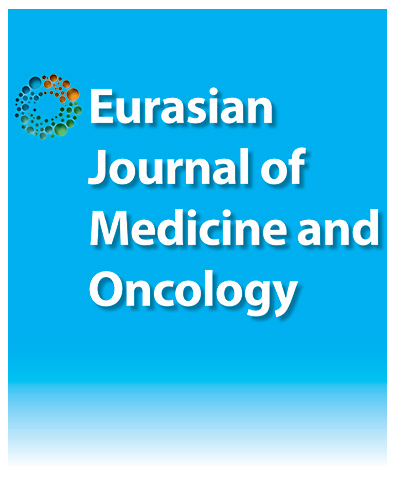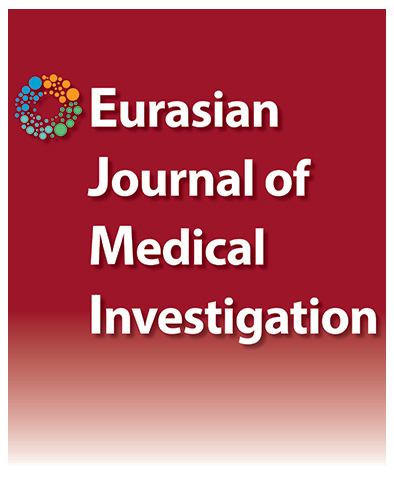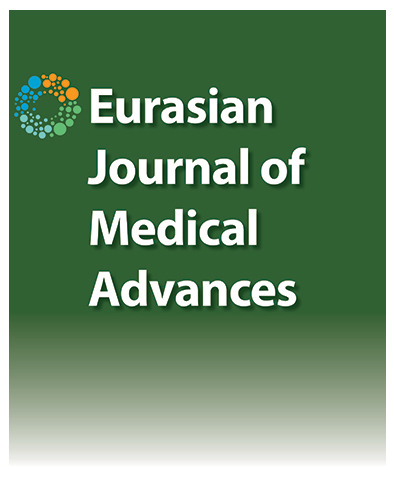Volume: 2 Issue: 1 - 2022
| RESEARCH ARTICLE | |
| 1. | Protective Effects of Silymarin on Acetaminophen-Induced Toxic Hepatitis Abdilkerim Oyman, Gulbin Unsal, Nurettin Aydogdu, Ufuk Usta doi: 10.14744/ejma.2022.32042 Pages 1 - 6 Objectives: Acetaminophen can cause liver damage that can result with death when it is taken as high doses. In our study we proposed to examine the silymarin effect on acetaminophen induced hepatotoxicity. Methods: In this study, 40 wistar albino rats are randomly divided into 4 groups. 1 ml 0.9% serum physiologic was injected to intraperitoneal (IP) area in control group (group 1). 100 mg/kg silymarin was also injected to IP area in second group (group 2). 1250 mg/kg acetaminophen was injected to IP area in toxic group (group 3). And after 4 hours 1250 mg/kg IP injection of acetaminophen to treatment group (group 4) 100 mg/kg of silymarin was administered to this group. All rats were sacrificed after 24 hours. Results: In treatment group, acetaminophen, alanine aminotransferase, aspartate aminotransferase, alkaline phosphatase, glutamyltransferase, total bilirubin, direct bilirubin levels which are found increased in toxic group, are found as decreased and statistically significant. The malondialdehyde, a lipid peroksidation product, levels are high in toxic group and low in treatment group and it was statistically significant. There was no significant difference between groups, liver histopathological features. Conclusion: With this findings it can be assumed that silymarin has hepatoprotective effect. |
| 2. | Detailed Analysis of Follicular Lymphoma over 25 Years: A Single-Center, Retrospective Study Hasan Cagri Yildirim, Fatos Dilan Atilla, Fahri Sahin, Guray Saydam, Filiz Vural, Murat Tombuloglu, Mahmut Tobu doi: 10.14744/ejma.2022.35220 Pages 7 - 12 Objectives: Follicular lymphoma is the most common indolent non-Hodgkin lymphoma. The course of the disease varies according to several parameters, so individualized treatments should be pursued. Many studies have shown positive effects of complete response to first-line chemoimmunotherapy on progression free survival (PFS) and overall survival (OS). In our study, we aimed to determine prognostic value of the risk factors that will predict the response to first-line chemoimmunotherapy. Methods: Demographic data, histopathological characteristics, imaging and laboratory tests of the patients were evaluated retrospectively and recorded with survival data. Patients with and without complete response (CR) were compared. Results: Ninety-one patients diagnosed and treated over 25 years were included in this study. Seventy-six patients who met GELF criteria received first line chemoimmunotherapy, followed by with or without maintenance rituximab for 2 years. Diagnosis at the age>60, higher FLIPI score, bone marrow involvement and hyperuricemia were associated with lower complete response rates (p=0.045, p=0.001, p=0.048, p=0.004, respectively). There was no significant association between rituximab therapy and PFS-OS rates. Conclusion: In our study, age over 60 years, high FLIPI score, bone marrow involvement and high uric acid levels were associated with low CR rates to first-line chemoimmunotherapy. The impact of CR and maintenance therapy on PFS and OS was not achieved. |
| CASE REPORT | |
| 3. | Posttransplant Lymphoproliferative Disease (PTLPD)-Central Nervous System (CNS) Involvement in a Case With Liver Transplantation: Case Report and Review of the Literature Merve Kakci, Semra Paydas, Arbil Acikalin, Sedef Kuran doi: 10.14744/ejma.2022.68077 Pages 13 - 16 Post transplant lenfoproliferative diseases (PTLPD) are generally seen in cases with solid organ transplantation (SOT) and relatively less commonly after stem cell transplantation and related with EBV infection, in 70-90% of the cases. Most commonly occurs within one year of transplantation althoug this entity may develop later than 4-6 years. Here a case with PTLPD with CNS involvement has been reported and literature has been reviewed. |
| 4. | An Unusual Presentation of Growing Teratoma Syndrome Cihan Erol, Mehmet Ali Nahit Sendur, Bulent Yalcin doi: 10.14744/ejma.2022.98608 Pages 17 - 19 The growing teratoma syndroma (GTS) was first defined in 1982 as growth in masses despite the decrease of serum tumor markers after treatment with cytotoxic chemotherapy in non-seminamatous germ cell tumors. Due to the rarity of the GTS, tumor growth should not be mistaken for disease progression. Because this may cause oncological overtreatment in some patients. GTS is most common in the retroperitoneal region. However, it has been reported elsewhere (lung, lymph nodes, mediastinum, liver, and pineal gland). Since GTS is not responsive to chemotherapy and radiotherapy, the gold standart of treatment is the radical surgical excision of the mass. There are very few cases of GTS in the literature that develop from the supraclavicular lymph node. Here we present an unusual case of GTS at left supraclavicular and subcarinal lymph nodes. |
| 5. | Castleman's Disease with a Rare Paraduodenal Localization Treated by Laparoscopy: Case Report and Literature Review Emrah Akin, Ahmet Tarik Harmantepe, Bilge Elcin, Ugur Can Dülger, Metin Senol, Fatih Altintoprak doi: 10.14744/ejma.2022.76486 Pages 20 - 22 Castleman disease is a rare proliferation disorder of the lymphatic system. Castleman Disease occurs less frequently in the mesenteric-paraduodenal localization. Surgical complete resection is recommended for the diagnosis and treatment of symptomatic paraduodenal masses. The number of reported cases of laparoscopic resection of Castleman's Disease located in the paraduodenal region is quite low in the literature. This article aims to present a rare case with characteristic histological and radiological findings treated with a laparoscopic approach. |






